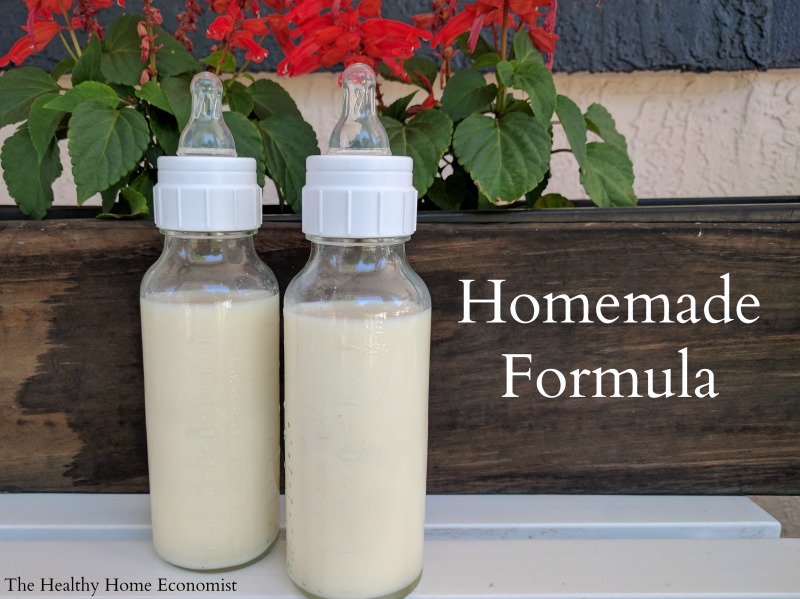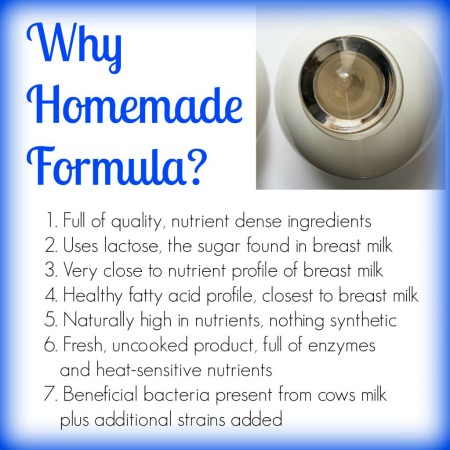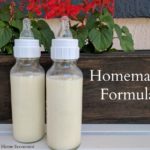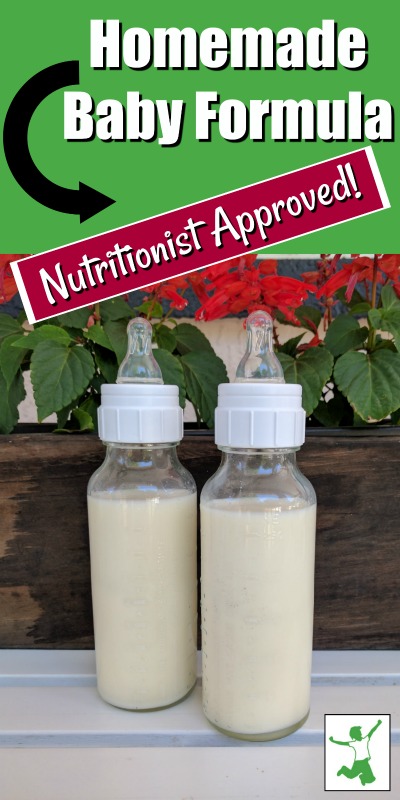Table of Contents[Hide][Show]
A nourishing homemade baby formula using safe, whole ingredients. This recipe was developed and tested by Dr. Mary Enig, a PhD Nutritionist and originally published in Nourishing Traditions cookbook in 1996. It was formulated to match breastmilk as closely as possible and is also suitable for infants. Source: Weston A. Price Foundation

There is no doubt that breastfeeding your baby is the best option for the child’s long-term health and development. Human breastmilk from a well-nourished mother is the perfect food for baby. However, in circumstances where the child is adopted or the Mother finds herself unable to breastfeed, formula feeding becomes necessary. In those cases, homemade baby formula is best.
Using a baby formula recipe that closely matches the nutritional profile of breastmilk is a far better choice than even organic baby formula from the health food store. More on this below.
Note: Donor programs are widely available for human breastmilk. But, the diets of the donor mothers are unknown and most likely nutritionally insufficient. In addition, breastmilk banks pasteurize the donated breastmilk which destroys much of the nutritional benefit. Unless you are fortunate to have a trusted and direct donor milk source in your community, avoid this option!
Dangers of Commercial Formula
Commercial formulas are always a poor choice for a number of reasons. First of all, formula manufacturers line the cans with the chemical BPA. This substance disrupts hormone development and is a probable contributor to early puberty in girls, and ADHD, urogenital abnormalities, and other ills in boys.
The European Food Safety Authority found that canned commercial formula is a significant source of BPA for infants, exposing the child to 13mcg of BPA per kg of body weight per day! BPA-free formula cans are no better. The chemical BPS is typically used instead which is just as dangerous.
Beware that manufacturers pack even organic commercial formula like Earth’s Best in BPA cans. Worse, they use organic brown rice syrup as the primary sweetener which is known to be frequently contaminated with arsenic.
In addition, all commercial milk formulas are processed at extremely high temperatures which violently denature the fragile milk proteins, render them allergenic, and add carcinogens to the final product. Soy infant formula is the worst. Obscenely high processing temperatures not only denature the proteins but large levels of phytic acid in soy block mineral absorption by the infant. Moreover, soy-based plant estrogens disrupt the hormonal development of the baby!
It seems that for the concerned Mother who is unable to breastfeed, learning how to make baby formula at home with safe, pure ingredients is the most prudent way to go!
Why Make Homemade Formula Even if You Are Breastfeeding
In the video below, I show you how to make your own safe, healthy raw milk homemade formula for your baby.
The recipe I follow was originally published in the cookbook Nourishing Traditions in 1996 and developed by Dr. Mary Enig.
Even though I breastfed each of my children for at least 2 years, I made this exact formula for my own children when I was away for the day or the evening as pumping was not an option that worked well for me.
I even used this homemade formula for an entire day once when I had some dental work done and was advised to pump and discard for 24 hours.
As a result, even successfully breastfeeding Moms can use this wonderful homemade formula as a supplement when necessary to their own nutrient-dense breastmilk!
It is advised that even breastfeeding Mothers have the ingredients for this formula on hand for an emergency. If Mom is sick or otherwise unable to nurse, Dad can step in and make this safe alternative until Mom is back on her feet. It takes a few days to a week to gather all the ingredients together to make this formula, which is why I advise having them on hand at all times.
Homemade Most Nutritious
The image below lists the reasons why it is worth it nutritionally to make formula yourself for your precious baby!
You can order all of the required ingredients for the homemade baby formula in one package from this reputable, vetted source.
Moms who have successfully used this formula feeding your children, please post about your experience in the comments section to encourage those who are considering it and need some Mom to Mom encouragement!

Where to Source Quality Milk
The most widely available grass-fed milk around the world is from cows. This is usually the most budget-friendly and easily sourced milk for this recipe for homemade formula.
If only goat milk is available in your area, this recipe for goat milk baby formula can be used instead. When using milk from ewes, please refer to the linked article for an adjusted recipe; one of the benefits of sheep milk is that it is higher in healthy fats than either goat or cow milk.
Camel milk formula is another option that is a particularly digestible form of dairy and growing in popularity around the world.
Alternatively, you can use low temp (vat) pasteurized, non-homogenized whole milk cultured with a piima or kefir starter. Then substitute the piima milk or kefir for the raw milk portion of the formula recipe. Cold-pressed raw milk also must be cultured before using it as it contains no probiotics.
Do NOT use ultrapasteurized (UHT) milk even if organic as it is too highly processed and extremely allergenic!
It is also best to avoid all types of powdered milk for this recipe. The factory process of making milk powder reduces nutrition considerably and denatures it, which makes it more likely baby will have an allergic reaction.
Dairy Allergy Option
If all types of dairy prove unsuitable for your baby, make this nondairy baby formula recipe instead. It uses a base of homemade bone broth as a substitute for milk. It is important not to utilize a plant-based or otherwise vegan baby formula recipe.
Avoid buying bone broth to make the dairy-free formula. Make it yourself! Manufacturers of commercial bone broth, even if authentic, may water down the end product. This is apparent if it does not gel when chilled in the refrigerator.
Many brands have toxic packaging issues as well. If you must buy it in a pinch, see my shopping guide page for vetted brands that are safe.

Homemade Baby Formula Recipe (for infants too)
A nourishing baby formula recipe you can make at home with safe, whole ingredients developed and tested by a PhD nutritionist to match breastmilk as closely as possible. Also suitable for infants.
Ingredients
- 2 cups raw cow milk OR organic whole milk yogurt
- 1 7/8 cups filtered water
- 1/4 cup liquid whey
- 4 Tbl lactose
- 1/4 tsp Bifidobacterium infantis powder
- 2-4 Tbl raw or pasteurized cream
- 1/2 tsp cod liver oil unflavored
- 1/4 tsp butter oil unflavored
- 1 tsp sunflower oil preferably organic
- 1 tsp extra virgin olive oil preferably organic
- 2 tsp virgin coconut oil preferably organic
- 2 tsp nutritional yeast
- 2 tsp gelatin
- 1/4 tsp acerola powder
Instructions
-
Fill a 2 cup Pyrex measuring cup with filtered water and remove 2 TBL (this will give you 1 7/8 cup water).
-
Pour about half the water into a pan and turn burner on medium.
-
Add the gelatin and lactose and let dissolve, stirring occasionally.
-
When gelatin and lactose are dissolved, remove pan from heat and add the rest of the water to cool.
-
Stir in the coconut oil and butter oil until melted.
-
Put remaining ingredients in a glass blender.
-
Add the water mixture and blend for about 3 seconds.
-
Place formula in glass baby bottles or a glass jar and refrigerate.
-
Before giving to baby, warm glass bottle in a pan of hot water or a bottle warmer. NEVER microwave baby bottles!
Recipe Video
Recipe Notes
If using raw cow milk from holstein cows, use 4 Tbl of extra cream (otherwise use 2 Tbl extra cream).
If choosing to make this homemade formula with camel milk, be sure to include 4 Tbl extra cream as camel milk is lower in cream than cow milk.
Do not use high oleic sunflower oil. Use only the brand recommended in the ingredients list which is cold pressed, organic, unrefined, and low oleic.
*Do NOT use powdered whey from the store as it is denatured. Avoid whey from making cheese as it will curdle the formula.
*Do not substitute pasteurized or powdered milk as these are heavily processed, denatured and allergenic foods.
*Do NOT use ultrapasteurized (UHT) cream. It is highly allergenic. Raw or pasteurized cream is acceptable.
*Do NOT use fish oil or krill oil instead of high vitamin cod liver oil as they do not contain any Vitamin D and very little to no Vitamin A.
Collagen powder may be substituted for the gelatin in a pinch (more on peptides in baby formula in this article).
If you are wondering where is the iron in homemade baby formula, this article provides an explanation.
If baby experiences constipation using this formula, try adding 1 tsp of molasses to each batch. This should help move things along.
How to Transition to DIY Formula
Once you’ve viewed the video, gathered the ingredients, and made your first batch, how do you feed it to your baby for the first time?
It is important not to switch all at once as this can cause gas, excessive spit-up, or an uncomfortable change in diaper habits such as constipation or overly loose stools.
Start by giving your baby three-quarters of the old formula blended with one-quarter of the homemade. Try this ratio for a day or two and see how your infant responds.
If no digestive upset or major change in diaper habits occurs, increase the amount to a 50-50 blend of old formula to homemade. Observe for another day or two as before.
If no major issues, increase once again to three-quarters homemade formula to one-quarter old formula. If baby does well on this blend for a third time, you are ready to fully transition to the homemade formula.
At any time during the transition, symptoms of intolerance emerge, back up to the previous successful blend ratio and stay there for a day or two before attempting to increase once again.
Homemade Formula FAQ
Weston Price Foundation
Feeding an Adopted Baby
Traveling Tips with Baby Formula Made at Home
Iron in Baby Formula
Collagen Peptides instead of Gelatin for Homemade Formula?










can raw goats milk be used instead of cows milk?
Hi. Just a quick question. My daughter is 16 months and I am just now stopping the raw milk formula recipe, do you think it’s okay she drank it this long? She only drank about 13 ounces or so a day in the past 2 months or so. She doesn’t like just plain raw milk so I continued to use the recipe. Now I’m worried she had too much for too long. Any thoughts on this ? Just worried about being taxing on the liver or kidneys from the oils.???? She est well, pretty much meats, veggies, fruit etc. I’m Judy going to try raw milk only now and keep up with probiotics and cod liver oil only. But , do you think she is okay being on it until 15 months old?
We just started my 4 month old son on this formula this week. He takes it fine but he is spitting up a lot more than with the Earths Best Formula for fussiness and has he was on. He was on that b/c he has always been very gassy and spitty. the amount of spit up has drastically increased and It stinks to high heaven too! It actually turns my stomach to smell my boy! With the next batch we are reducing the nutritional yeast like the Weston A. Price website suggests. Any other suggestions? I want to use this instead of the powdered organic formula but the amount of spot up and the vomit smell are just awful.
Ashley, I am having that same issue which is why I’m reading comments from others and looking for answers. Has anything you’ve done helped with the spit up or the smell? did you have to go back to the powdered organic regular formula? Please let me know if you can. Thank you.
Sarah, my son is going to be 10 months soon and I’d like to try the homemade formula but I was wondering if I could get all the ingredients at WholeFoods. Do you think goat milk is another alternative, my baby needs to gain a little weight since he fell off the chart from losing his appetite due to teething. Thank you for your help
I have been supplementing with the formula for the last three months. It seems now that my 8month older is breaking out in bumps/rash (diaper area, stomach, face, arms and back). I don’t think he is allergic to milk as I tried him on commercial formula and he does well! I suspect it is one of the ingredients in the formula. Have you had anyone that has had this same problem? I would like to continue making the homade formula but unsure of how to tweak it. I tried the broth based formula and my baby did not like it.
I have been supplementing BF with this formula for two months, with my twins. They both liked it until my hubby accidentally added 1 extra tsp of yeast flakes. My little guy vomited, and won’t take the formula since. I’ve reduced the amount to only 1 tsp yeast, but he still won’t drink it. Do you have any suggestions for ingredients to omit / ways to change it so he might like it? I think it’s more than the yeast flakes he’s objecting to at this point. Thank you.
im afraid to use raw milk, because i bought some for my other two kids (ages 6 and 3 healthy boys) and two to three days later they were very sick. its winter now so the cows were not eating grass… and i dont know if they are clean when milking the cows….when i make this recipe can i buy raw milk but then boil it to kill any harmful bacteria, then refrigerate it in a glass bottle when cooled down then atempt to make formula then? Back in my native country Azores the milk tastes really different there, its better,but my mother would always boil it first.(maybe it wasnt homogonized). If my baby doesnt seem to like the taste of this formula, what can i do to make it more appetizing… add a sweetener of any kind?
Also i found out about Babys only organic formula seems to be gmo free but some studys show tons of arsenic in organic brown rice syrup, and thats the first ingredient in it..
I believe your other children may have had stomach upset because their bodies aren’t used to the enzymes in the raw milk. You cannot immediately switch them over to raw milk when they have never had it before. It has to be a process of introducing it slowly. Also, I would not pasteurize the milk at home, as this ruins the whole purpose. Unless you low-temp pasteurized it and then cultured it with some milk Kefir grains. However, the raw milk is much better for them (my, and most others’ opinions on this site). Most likely the baby will love the taste of the formula. If you are worried about the Cod Liver Oil, you can purchase a flavored one like lemon or cinnamon or whatever you prefer. Once my baby had this formula he refused powdered formula. Taste them both and see what you think. The RMF is much better and has a pleasing sweet aftertaste. Also, the sweetener in the formula is the lactose. There is a WAP yahoo group that you can join they will answer your questions and you will get a lot more opinions. Hope that helps!
I just left you a really long comment and it didn’t post for some reason. I will make this short and sweet. The lactose in the formula is the sweetener. It tastes great with a sweet aftertaste. If you are worried about the Cod Liver Oil they have great flavors. Do not boil the milk, it ruins the whole point. Your children probably had a bad reaction because their bodies are not used to the enzymes. You have to introduce raw milk slowly. There is a WAP yahoo group where tons of people will answer your questions. Here is the link:
Yes, it did post. lol
to add to what mary said about how it tastes, I have tasted the homemade formula and it really isn’t bad. also my 2 and a half year old asks for a cup every time I make it. Now commercial formula is disgusting. I would stick with the plain cod liver oil flavor because you really can’t taste it in the formula. it’s only a half teaspoon per 36 ounces. I like to stick to plain flavors so my kids don’t start demanding flavored milks and yogurts that often have extra sugar or bad stuff in them.
thank you so much Mary,and also Rebeca…. I apreciate all your comments, it helped me alot, i feel more confident about making this formula for my baby.. Do you think that i should introduce this slowly into his diet?
As soon as I got the ingredients together (ordered all of them online except for the dairy), I just jumped right in and started feeding it to him, but I did add some breastmilk to the bottles. If you are only feeding formula, I say just go for it, unless your child is really sensitive to things. If you have breastmilk, try mixing half and half. My son didn’t have any problem going straight onto the formula, but of course every child may be different. The sooner they stop taking commercial formula, the better, in my opinion.
The only reason to be afraid of raw milk is if the cows and sick and dirty. First of all, that would be bad for business, so why would farmer’s do that? The best way to be confident about your milk is to check out the farm, talk to the people, talk to other people that buy the milk. Do your homework. If you boil raw milk, you may as buy pasteurized milk, because you will be pasteurizing it yourself by boiling it and you will kill all the good parts of the milk like the enzymes, and denaturing the proteins, etc. In other words it will no longer have those health benefits. If the cows are healthy, and they clean the cows with iodine or similar before milking, and put the milk into cold storage, the raw milk should be fine. Milk from the cow is not homogenized, that means that the fat has been mixed into the milk in a way that it cannot separate, the process of doing that harms the milk. I am also concerned about all commercial baby formula and so I make this homemade formula instead and it is great for my baby, he loves it and he is healthier and gaining weight really well. He was a two month premature baby, but now at five months he weighs almost the same as his one year old cousin, about 16 pounds.
How do you know the local raw milk you buy is safe? In Florida it is only supposed to be consumed by animals according to law. This is giving me some concern.
I’ve heard others say that they label it for pets only to get around laws against selling to humans. The best way to know if the milk is safe is to find out how they do things on the farm where it is produced and to ask questions. In your case maybe you want to ask other customers. I bet most of them use it for themselves and their families. In my state it is legal to sell to people. There are a lot of myths out there about raw milk, and probably a big dairy lobby that are affecting the laws to promote their products that try to make raw milk illegal for humans.